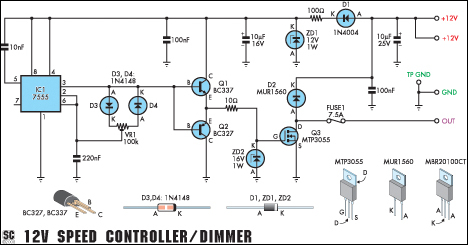
100W inverter 12V to 220VAC

To lower or raise a specific voltage, a transformer is typically used; however, this component does not operate with direct current, which is available in batteries or vehicles. Therefore, an oscillator is required to generate alternating current. The integrated circuit (CD4047) serves as an oscillator. An inverter is a device or system that creates alternating current by connecting to a DC source. Inverters can be defined as the inverse function of rectification, where rectifiers convert alternating current into direct current, while inverters convert DC voltage to AC. The schematic for a DC to AC inverter converts 12V to 220V and is suitable for power users needing 220V alternating voltage with a total capacity of up to 100 watts. The inverter consists of a master oscillator (symmetrical multivibrator using VT1 and VT2). Additionally, there is a schematic diagram for an inverter circuit designed for a 40W fluorescent light, which is ideal for emergency lighting. This inverter can power 40W fluorescent tubes from any 12V source capable of delivering 3A. The circuit is simple, inexpensive, and easy to assemble, with safety precautions advised. There is also a circuit diagram for an inverter suitable for an 8W fluorescent lamp, built using a ZTX652 transistor, allowing the operation of an 8W fluorescent lamp from a 12V source. The inverter operates with a DC supply ranging from 10V to 16.5V, achieving efficiencies of up to 78%, making it suitable for various applications.
The inverter circuit designed for converting 12V DC to 220V AC is an essential component for users requiring a reliable source of alternating current, particularly in scenarios where conventional AC power is unavailable. The core of the inverter utilizes the CD4047 integrated circuit, which functions as an oscillator to produce a square wave output. This square wave is then used to drive a pair of transistors (VT1 and VT2), configured in a push-pull arrangement, to switch the current through the transformer, thereby generating the desired AC output.
The transformer steps up the voltage from 12V to 220V, allowing the inverter to cater to various devices that require standard household voltage levels. The circuit design includes protective features to prevent damage to the components during operation, ensuring longevity and reliability.
For the 40W fluorescent lamp inverter, the circuit is optimized to provide sufficient power while remaining compact and efficient. The design leverages a simple multivibrator configuration to create the necessary oscillation frequency, which is crucial for the effective operation of the fluorescent lamp. The inverter's ability to operate from a 12V source makes it highly versatile, suitable for use in automotive applications or portable power solutions.
The 8W fluorescent lamp inverter, utilizing the ZTX652 transistor, showcases a more compact design that is specifically tailored for lower power applications. This inverter circuit operates efficiently within a specified voltage range, ensuring stable performance while minimizing energy loss.
Overall, these inverter designs exemplify practical solutions for converting DC to AC power, accommodating various wattage requirements, and providing essential functionality in emergency and portable applications. Safety measures and proper component selection are critical to ensure efficient operation and to mitigate risks associated with high voltage generation.To lower or raise any specific voltage is better adapted from a transformer, but this component does not operate in direct current, which is available in battery or vehicle. Therefore we must put an oscillator that generates an alternative current. The Integrated circuit (CD4047) is an oscillator that has the. Inverter is the device, scheme, or s ystem that creates alternating current by connecting the DC source. There is another way to define: an inversion - the inverse function of rectification. Rectifiers convert alternating current into a constant, and the inverters on the contrary, make the DC voltage to AC. Inverters. The scheme of the inverter DC to AC 12 to 220 V. This inverter is suitable for power users who need an alternating voltage of 220 V with a total capacity of up to 100 watts.
The inverter consists of a master oscillator (symmetrical multivibrator for VT1, VT2) and the. This is the schematic diagram of inverter circuit for 40W fluorescent light, this is great circuit for emergency lamp. This inverter allows you to power up 40W fluorescent tubes from any 12V source capable of delivering 3A.
The circuit is very simple, inexpensive and easy to build. Please use safety. This is the circuit diagram of inverter for 8W fluorescent lamp. The circuit is build based ZTX652 transistor, and used to drive an 8W fluorescent lamp from a 12V source. The inverter will work from 10V to 16. 5V DC supply, attaining efficiencies up to 78% thus making it suitable for. We aim to transmit more information by carrying articles. Please send us an E-mail to wanghuali@hqew. net within 15 days if we are involved in the problems of article content, copyright or other problems.
We will delete it soon. 🔗 External reference
The inverter circuit designed for converting 12V DC to 220V AC is an essential component for users requiring a reliable source of alternating current, particularly in scenarios where conventional AC power is unavailable. The core of the inverter utilizes the CD4047 integrated circuit, which functions as an oscillator to produce a square wave output. This square wave is then used to drive a pair of transistors (VT1 and VT2), configured in a push-pull arrangement, to switch the current through the transformer, thereby generating the desired AC output.
The transformer steps up the voltage from 12V to 220V, allowing the inverter to cater to various devices that require standard household voltage levels. The circuit design includes protective features to prevent damage to the components during operation, ensuring longevity and reliability.
For the 40W fluorescent lamp inverter, the circuit is optimized to provide sufficient power while remaining compact and efficient. The design leverages a simple multivibrator configuration to create the necessary oscillation frequency, which is crucial for the effective operation of the fluorescent lamp. The inverter's ability to operate from a 12V source makes it highly versatile, suitable for use in automotive applications or portable power solutions.
The 8W fluorescent lamp inverter, utilizing the ZTX652 transistor, showcases a more compact design that is specifically tailored for lower power applications. This inverter circuit operates efficiently within a specified voltage range, ensuring stable performance while minimizing energy loss.
Overall, these inverter designs exemplify practical solutions for converting DC to AC power, accommodating various wattage requirements, and providing essential functionality in emergency and portable applications. Safety measures and proper component selection are critical to ensure efficient operation and to mitigate risks associated with high voltage generation.To lower or raise any specific voltage is better adapted from a transformer, but this component does not operate in direct current, which is available in battery or vehicle. Therefore we must put an oscillator that generates an alternative current. The Integrated circuit (CD4047) is an oscillator that has the. Inverter is the device, scheme, or s ystem that creates alternating current by connecting the DC source. There is another way to define: an inversion - the inverse function of rectification. Rectifiers convert alternating current into a constant, and the inverters on the contrary, make the DC voltage to AC. Inverters. The scheme of the inverter DC to AC 12 to 220 V. This inverter is suitable for power users who need an alternating voltage of 220 V with a total capacity of up to 100 watts.
The inverter consists of a master oscillator (symmetrical multivibrator for VT1, VT2) and the. This is the schematic diagram of inverter circuit for 40W fluorescent light, this is great circuit for emergency lamp. This inverter allows you to power up 40W fluorescent tubes from any 12V source capable of delivering 3A.
The circuit is very simple, inexpensive and easy to build. Please use safety. This is the circuit diagram of inverter for 8W fluorescent lamp. The circuit is build based ZTX652 transistor, and used to drive an 8W fluorescent lamp from a 12V source. The inverter will work from 10V to 16. 5V DC supply, attaining efficiencies up to 78% thus making it suitable for. We aim to transmit more information by carrying articles. Please send us an E-mail to wanghuali@hqew. net within 15 days if we are involved in the problems of article content, copyright or other problems.
We will delete it soon. 🔗 External reference





